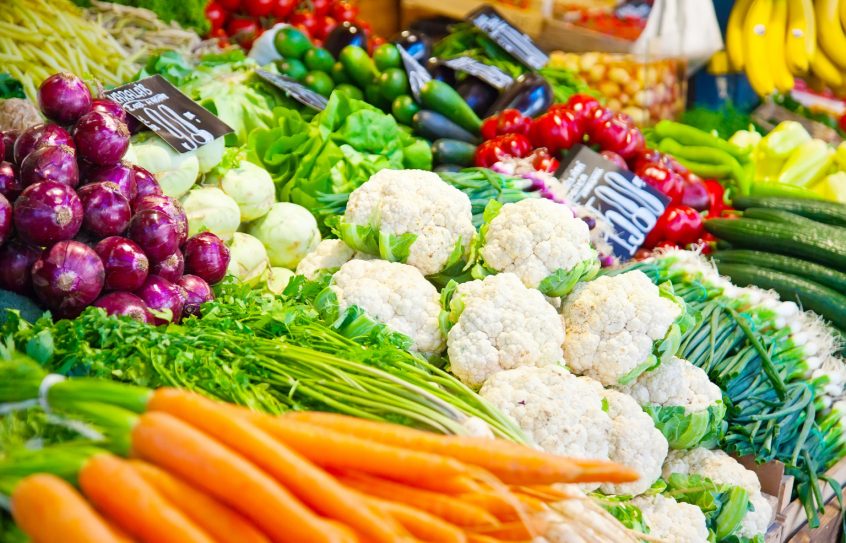We all know that fresh fruits and vegetables are good for us but did you know just HOW good they are?
Today I’m summarising some of the compelling evidence available regarding consumption of vegetables and fruit.
What do Fruits and Vegetables Contain?
Fresh fruits and vegetables are nature’s nutrient powerhouses(1). An individual can easily meet their requirements for all vitamins and minerals by eating wide variety of plant foods from all the vegetable and fruit families throughout the seasons, supplemented with protein from meats, poultry and fish, and whole-food healthy fats like olive oil, avocados, nuts, seeds, fatty fish and some coconut.
Vegetables and fruits eaten in their whole form don’t only provide the essential vitamins and minerals identified in the Nutrient Reference Values (2) but also contain hundreds, if not thousands, of other compounds called phytonutrients (3). Put simply, phytonutrients are molecules, (similar to our named vitamins and minerals) that exist in the plant and participate in reactions in our body. They may have interactions with nutrient absorption in the gut, antioxidant and anti-inflammatory effects, detoxifying effects, aid DNA repair and aid intracellular communication(4). Some examples of phytonutrients include polyphenols, phytates, phytoestrogens, flavonoids and carotenoids. We miss out on these phytonutrients when we take nutrient supplements (which contain only the vitamins/minerals specified on the label, not the wholefood) or consume inadequate amounts of fruits and vegetables.

Evidence of the health benefits of Fruit and Vegetables
There have been many studies investigating the link between fruit and vegetable consumption and health outcomes. What is overwhelmingly consistent among the studies, and the overarching meta-analyses performed, is that increased fruit and vegetable consumption is inversely related to poor health outcomes. That is; increased F&V intake is associated with reduced risk of poor health.
A 2014 study (5) found that for every 1 serve per day increase in fruit and vegetable intake, an individual’s risk of all-cause mortality DECREASED by 5%. Similar results were seen in a meta-analysis carried out by Hu et al. (6). Finding that a person’s risk of stroke decreased by 32% for every extra 200g of fruit consumed per day and 11% for every 200g of vegetables consumed per day.
He et al. (7, 8) confirmed this again showing that individuals who ate 3-5 servings per day of fruit & vegetables were 11% less likely to have a stroke and 7% less likely to develop Heart Disease (compared to those who ate less than 3 servings). Further, those who ate MORE than 5 serves per day were 26% less likely to have a stroke and 17% less likely to develop Heart Disease.
The conclusion is clear: the more fruit and vegetables eaten, the more your risk of disease decreases.
These pooled results provide strong support for the recommendation to consume more than 5 servings of fruit and vegetables per day to cause a major reduction in risk for stroke, Heart Disease and diabetes-related deaths.
However, the most recent Australian Health Survey (carried out in 2011-12)(9) found that only 5.5% of Australian adults consumed the recommended 2 serves of fruit and 5 serves of vegetables per day. That’s 1 in 20 people! In fact, almost 20% of adults reported a fruit intake of <1 serving and 56% reported a vegetable intake of <3 servings per day.
It’s no wonder that Australia’s leading cause of death is Heart Disease closely followed by related conditions like stroke, heart attack and diabetes-related deaths.

Pumpkin & Quinoa Bites with Salad
So. What do we do?
EAT MORE FRUIT AND VEGGIES! The recommendations by the government for 5 serves of veggies per day should be used as a MINIMUM. Crowd your plates out with veggies so that there isn’t much room left for any bad stuff. Snack on veggies and fruit with nuts and seeds and homemade dips.
I have loads of recipes on this website with ideas for how to use vegetables. If you need personal help or have a group that you think would benefit from a few sessions with me then send me an email or comment below!
Bibliography
1. Whitney EN, Cameron-Smith D, Crowe T, Walsh A, Rady Rolfes S. Understanding nutrition: 2nd edition.; 2014.
2. Council NH, Medical R. Nutrient Reference Values. Nutrients. Canberra: Australian Government; 2016.
3. Nones K, Villas‐Bôas SG. Evaluation of the Beneficial Effects of Phytonutrients by Metabolomics. Genomics, Proteomics, and Metabolomics in Nutraceuticals and Functional Foods. 2010:287-96.
4. Chung RTM. Detoxification effects of phytonutrients against environmental toxicants and sharing of clinical experience on practical applications. Environmental Science and Pollution Research. 2015:1-11.
5. Wang X, Ouyang Y, Liu J, Zhu M, Zhao G, Bao W, et al. Fruit and vegetable consumption and mortality from all causes, cardiovascular disease, and cancer: systematic review and dose-response meta-analysis of prospective cohort studies. BMJ : British Medical Journal. 2014;349.
6. Hu D, Huang J, Wang Y, Zhang D, Qu Y. Fruits and Vegetables Consumption and Risk of Stroke. A Meta-Analysis of Prospective Cohort Studies. 2014;45(6):1613-9.
7. He FJ, Nowson CA, MacGregor GA. Fruit and vegetable consumption and stroke: meta-analysis of cohort studies. Lancet (London, England). 2006;367(9507):320-6.
8. He F, Nowson C, Lucas M, MacGregor G. Increased consumption of fruit and vegetables is related to a reduced risk of coronary heart disease: meta-analysis of cohort studies. Journal of human hypertension. 2007;21(9):717-28.
9. Statistics ABo. Australian Health Survey: Nutrition First Results – Foods and Nutrients, 2011-12. Canberra, Australia: The Australian Bureau of Statistics; 2014.

